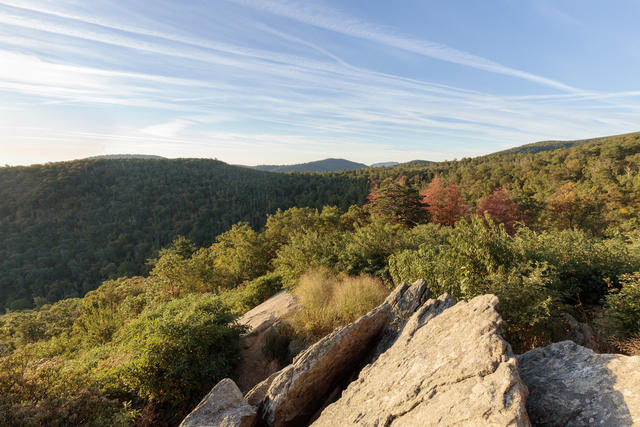Home » Regions » North America » Eastern Temperate Forests » Ozark, Oauchita-Appalachian Forests » Blue Ridge » Northern Igneous Ridges
Northern Igneous Ridges
Last updated: February 27th, 2020
Page contents
↑About the Northern Igneous Ridges
The Northern Igneous Ridges are one of the two regions making up the northernmost portion of the Blue Ridge They are the wider of these two regions, and the more southeasterly one (closer to the coast) in most places. They stretch from Pennsylvania (near South Mountain) through Maryland and well into Virginia.Like the bordering Northern Sedimentary and Metasedimentary Ridges region, this region consists of long ridges. Unlike that region though, the ridgetops branch less and there are more isolated mountain peaks. There are fewer small valleys and more large valleys and gaps. The elevation and relief are both slightly higher.
Soils here are rocky, acidic, and nutrient poor. This area was originally covered by Appalachian Oak Forest, and is still mostly forested. There is a small amount of dairy farming and orchards in this area.
Along most of its length, this region is bordered to the northwest (inland) by the similar but slightly less rugged Northern Sedimentary and Metasedimentary Ridges. Southeast, towards the coast, this region is bordered by various parts of the Northern Piedmont in the north, mostly the Piedmont Uplands, and by the Northern Inner Piedmont in the south.
 This photo, taken from Hazel Mountain Overlook along Skyline drive, shows a landscape typical of the Northern Igneous Ridges of the Blue Ridge, with long ridges, mostly unbranched, with numerous isolated peaks, and a mostly-forested landscape. Photo © Neal Lewis, National Park Service, Public Domain, Source.
This photo, taken from Hazel Mountain Overlook along Skyline drive, shows a landscape typical of the Northern Igneous Ridges of the Blue Ridge, with long ridges, mostly unbranched, with numerous isolated peaks, and a mostly-forested landscape. Photo © Neal Lewis, National Park Service, Public Domain, Source.Plant Lists & In-Region Search
We do not yet have data to generate plant lists for a region as fine-tuned as this one. However you can move up to the broader Blue Ridge and generate lists for that region: native plants or all plants. Or search that region's plants here:
↑References
1. Woods, A.J, Omernik, J.M., Brown, D.D. "Level III and IV Ecoregions of Delaware, Maryland, Pennsylvania, Virginia, and West Virginia", U.S. Environmental Protection Agency: National Health and Environmental Effects Research Laboratory, Corvallis, OR (1999) Web.


